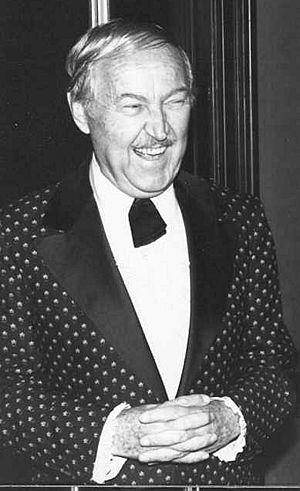George Pal facts for kids
Quick facts for kids
George Pal
|
|
|---|---|

Pal in 1979
|
|
| Born |
György Pál Marczincsak
February 1, 1908 Cegléd, Austria-Hungary
|
| Died | May 2, 1980 (aged 72) Los Angeles, California, U.S.
|
| Resting place | Holy Cross Cemetery, Culver City, California |
| Nationality | Hungarian, American |
| Other names | Julius György Marczincsak |
| Citizenship | American |
| Alma mater | Hungarian University of Fine Arts |
| Years active | 1934–1975 |
| Spouse(s) | Elisabeth "Zsoka" Pal (m.1930) |
| Children | 2 sons |
| Awards | See Awards and Honours |
George Pal (born György Pál Marczincsak; February 1, 1908 – May 2, 1980) was a talented Hungarian-American filmmaker. He was known for making amazing animated films and later, exciting science-fiction and fantasy movies. He moved from Europe to the United States and became an American citizen.
George Pal was nominated for an Academy Award (also known as an Oscar) seven years in a row, from 1942 to 1948, for his animated short films. He even received a special honorary Oscar in 1944 for his creative work.
Contents
Early Life and Amazing Animations
George Pal was born in Cegléd, Hungary, in 1908. He studied at the Hungarian University of Fine Arts and graduated when he was 20. After that, he started making films in Budapest.
In 1931, when he was 23, he married Elisabeth "Zsóka" Grandjean. They moved to Berlin, Germany, where he started his own film studio. It was here that he invented a special animation technique called the Pal-Doll technique. In the United States, these films became famous as Puppetoons.
He left Germany as the Nazis came to power. He continued making films in other countries like France and the Netherlands. Before moving to the United States, he made five films for a British company. In December 1939, when he was 32, he moved to the United States and started working for Paramount Pictures. His friend, Walter Lantz, helped him become an American citizen.
In the 1940s, George Pal became famous for his Puppetoons series. These were short animated films made using his special stop-motion technique. Because of his new and creative methods, he received an honorary Oscar in 1943.
After his success with animation, Pal started making live-action movies. These were films with real actors, not just puppets. His first live-action film was The Great Rupert in 1950.
He is best known for producing many popular science-fiction and fantasy films in the 1950s and 1960s. Some of his famous movies include When Worlds Collide and The War of the Worlds. He also directed several films himself, like Tom Thumb (1958), The Time Machine (1960), and The Wonderful World of the Brothers Grimm (1962).
Later Life and Legacy
George Pal passed away in May 1980 in Beverly Hills, California, at the age of 72. He died from a heart attack. He is buried in Holy Cross Cemetery, Culver City, California. He was working on a film called The Voyage of the Berg when he died, but it was never finished.
Awards and Honours
George Pal has a special star on the Hollywood Walk of Fame in California. This is a big honor for people who have made a lasting impact in entertainment.
In 1980, the Academy of Motion Picture Arts and Sciences started a special series of talks called the "George Pal Lecture on Fantasy in Film." This was created to remember his amazing work in fantasy movies.
George Pal and his film When Worlds Collide are even mentioned in the opening song of the famous musical The Rocky Horror Show and its movie version, The Rocky Horror Picture Show.
In 1975, he received the Golden Plate Award from the Academy of Achievement. He also won the San Diego Comic Con Inkpot Award, which celebrates people who have contributed to comics, science fiction, and fantasy.
Some of Pal's Puppetoons, like Tulips Shall Grow and John Henry and the Inky-Poo, have been added to the Library of Congress National Film Registry. This means they are considered very important films that should be preserved. Also, some of his puppet models were given to the Smithsonian Institution for the National Museum of American History.
Preservation
The Academy Film Archive has worked to save and protect several of George Pal's films. These include Jasper and the Beanstalk, John Henry and the Inky Poo, and Radio Röhren Revolution. This helps make sure his creative work can be enjoyed by future generations.
Images for kids
See also
 In Spanish: George Pal para niños
In Spanish: George Pal para niños


